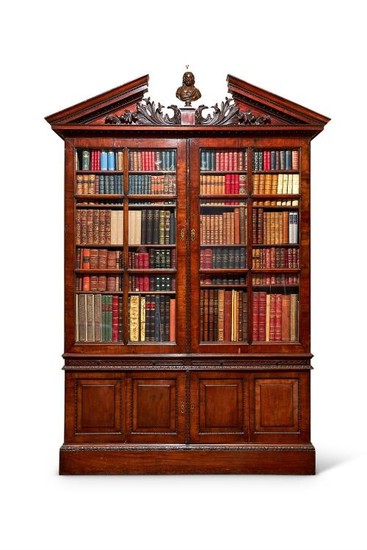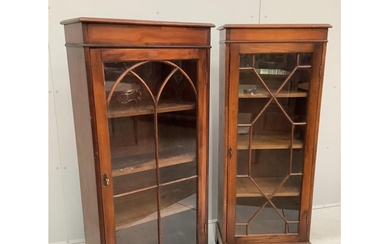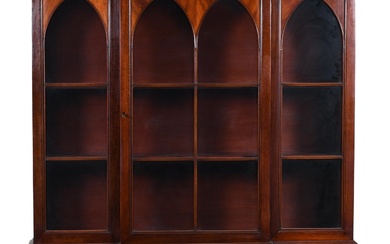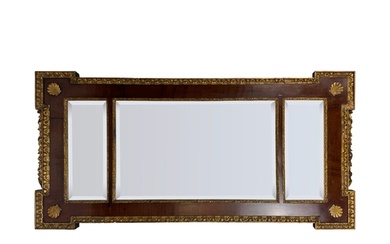A George II style mahogany library bookcase
A George II style mahogany library bookcase, the broken arch pediment with egg and dart mouldings and a central platform for a bust or vase flanked by acanthus scrolls with eagle head terminals, the pair of panelled astragal doors enclosing adjustable shelves, the lower part with a Vitruvian scroll-carved waist moulding incorporating a pair of book rests, the lower part with two pairs of articulated fielded-panel cupboard doors each enclosing a drawer and a shelf, on a plinth with a ribbon-and-rosette carved border, with associated bust, 293cm high, 208cm wide, 54cm deep
Provenance:
Bought by R.W. Symonds for Geoffrey Blackwell.
James Kenneth Weir, 2nd Viscount Weir of Eastwood CBE
Acquired by the present owner, anonymous sale, Christie's London, 12 March 1981, lot 108
Literature:
R.W. Symonds, 'Furniture in the Collection of Mr Geoffrey Blackwel', Apollo, April 1936, pp. 192-4, fig. II
P. Macquoid and R. Edwards, The Dictionary of English Furniture, London, 1954, vol. 1, p. 83, fig. 11.
R.W. Symonds 'A Fine Pair of Library Bookcases', Country Life, 29 May 1958, pp. 1176-7, fig. 1
P. Macquoid and R. Edwards, The Shorter Dictionary of English Furniture, London, rev. ed., 1964, p.53, fig. 7.
The present bookcase is designed in the Roman style first promoted by the architect Inigo Jones (d. 1637) and later adopted by Richard Boyle 3rd Earl of Burlington and his circle including William Kent. The centre of the pediment features Jupiter eagles flanking a bracket intended for the display of a bust. The design is shares similarities, in respect of its pediment and glazing bars with a Tuscan bookcase pattern of 1739, illustrated in Batty Langley's Treasury of Designs: or the Art of Drawing and Working the ornamental parts of Architecture, London, 1745, pl. 58. The eagles to the centre of the pediment are paralleled in Langley's design for a chimney-piece in Gothic Architecture Improv'd by Rules and Proportions, 1742 (pl. 47). The present bookcase sold Christie's 12 March 1981, lot 108, forming one of three lots (106-108) designated as 'The Property of a Nobleman'. Lot 106, another bookcase of a very similar design, was purchased by Geoffrey's Blackwell's son John. The latter catalogued as A George II mahogany bookcase, circa 1740, with minor alterations sold more recently (Euro 277,050) Christie's Antwerp, 'Axel Vervoordt', 10-12 May 2004, lot 110 with provenance: possibly supplied to the Fermor family, Tusmore, Oxfordshire and possibly sold with the house to the 2nd Earl of Effingham (d. 1889).
Condition Report:
Please note, this lot is 293cm high and not as printed in the catalogue. Shelf depth - 38cm. Marks, scratches and abrasions commensurate with age and use. Old chips and splits. Some old repairs. Some losses. The bookcase base and cabinets are constructed in a mahogany not typical of that used in the 18th century. The plinth is constructed from solid mahogany as opposed to veneered deal, as would be usual for an 18th century piece. The lower doors are secured with butt-hinges and pin-hinges dating from the late 19th or early 20th century (with no evidence of having been replaced). The back panels are mahogany and not deal or oak, as would be usual. The cabinet doors are veneered with knife-cut veneer. An 18th century piece would be veneered with thicker, saw-cut veneers. The cabinet door hinges date from the late 19th/early 20th century. The cabinet shelves of an 18th century bookcase would usually be oak or mahogany, with a fine moulded mahogany facing. The present shelves appear to be made from plain boards of Honduras mahogany. Overall the exterior bookcase has been applied with a coloured shellac. Overall the bookcase would not appear to pre date circa 1900. Please refer to additional images for visual reference to condition.
View it on
Sale price
Estimate
Time, Location
Auction House
A George II style mahogany library bookcase, the broken arch pediment with egg and dart mouldings and a central platform for a bust or vase flanked by acanthus scrolls with eagle head terminals, the pair of panelled astragal doors enclosing adjustable shelves, the lower part with a Vitruvian scroll-carved waist moulding incorporating a pair of book rests, the lower part with two pairs of articulated fielded-panel cupboard doors each enclosing a drawer and a shelf, on a plinth with a ribbon-and-rosette carved border, with associated bust, 293cm high, 208cm wide, 54cm deep
Provenance:
Bought by R.W. Symonds for Geoffrey Blackwell.
James Kenneth Weir, 2nd Viscount Weir of Eastwood CBE
Acquired by the present owner, anonymous sale, Christie's London, 12 March 1981, lot 108
Literature:
R.W. Symonds, 'Furniture in the Collection of Mr Geoffrey Blackwel', Apollo, April 1936, pp. 192-4, fig. II
P. Macquoid and R. Edwards, The Dictionary of English Furniture, London, 1954, vol. 1, p. 83, fig. 11.
R.W. Symonds 'A Fine Pair of Library Bookcases', Country Life, 29 May 1958, pp. 1176-7, fig. 1
P. Macquoid and R. Edwards, The Shorter Dictionary of English Furniture, London, rev. ed., 1964, p.53, fig. 7.
The present bookcase is designed in the Roman style first promoted by the architect Inigo Jones (d. 1637) and later adopted by Richard Boyle 3rd Earl of Burlington and his circle including William Kent. The centre of the pediment features Jupiter eagles flanking a bracket intended for the display of a bust. The design is shares similarities, in respect of its pediment and glazing bars with a Tuscan bookcase pattern of 1739, illustrated in Batty Langley's Treasury of Designs: or the Art of Drawing and Working the ornamental parts of Architecture, London, 1745, pl. 58. The eagles to the centre of the pediment are paralleled in Langley's design for a chimney-piece in Gothic Architecture Improv'd by Rules and Proportions, 1742 (pl. 47). The present bookcase sold Christie's 12 March 1981, lot 108, forming one of three lots (106-108) designated as 'The Property of a Nobleman'. Lot 106, another bookcase of a very similar design, was purchased by Geoffrey's Blackwell's son John. The latter catalogued as A George II mahogany bookcase, circa 1740, with minor alterations sold more recently (Euro 277,050) Christie's Antwerp, 'Axel Vervoordt', 10-12 May 2004, lot 110 with provenance: possibly supplied to the Fermor family, Tusmore, Oxfordshire and possibly sold with the house to the 2nd Earl of Effingham (d. 1889).
Condition Report:
Please note, this lot is 293cm high and not as printed in the catalogue. Shelf depth - 38cm. Marks, scratches and abrasions commensurate with age and use. Old chips and splits. Some old repairs. Some losses. The bookcase base and cabinets are constructed in a mahogany not typical of that used in the 18th century. The plinth is constructed from solid mahogany as opposed to veneered deal, as would be usual for an 18th century piece. The lower doors are secured with butt-hinges and pin-hinges dating from the late 19th or early 20th century (with no evidence of having been replaced). The back panels are mahogany and not deal or oak, as would be usual. The cabinet doors are veneered with knife-cut veneer. An 18th century piece would be veneered with thicker, saw-cut veneers. The cabinet door hinges date from the late 19th/early 20th century. The cabinet shelves of an 18th century bookcase would usually be oak or mahogany, with a fine moulded mahogany facing. The present shelves appear to be made from plain boards of Honduras mahogany. Overall the exterior bookcase has been applied with a coloured shellac. Overall the bookcase would not appear to pre date circa 1900. Please refer to additional images for visual reference to condition.







